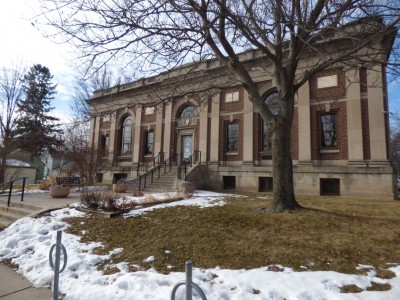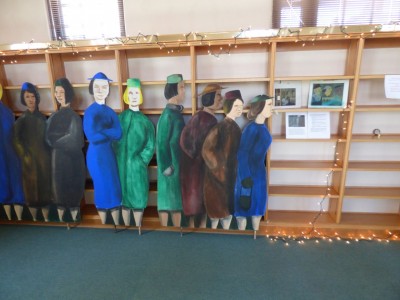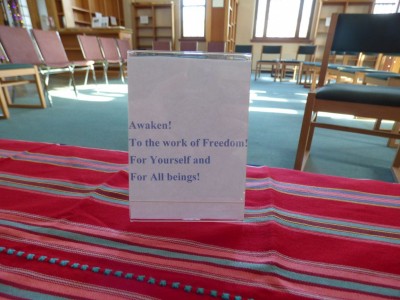
East Side Freedom Library wants people to create knowledge
On June 1st, 2014, educators Peter Rachleff and Beth Cleary, supported by a board of directors, formally launched the East Side Freedom Library. A Knight Arts grantee, this new institution is housed in the former Arlington Hills Library building through a 15-year lease with the City of St. Paul. The organization’s goal is to provide resources to support educational and cultural programs that reflect the neighborhood’s historic character as a home to immigrant workers, build bridges among its current residents, and raise its visibility in the Twin Cities.
Built as a Carnegie Library in 1917, the Arlington Hills Library served the neighborhood as a traditional library for decades. But a new Arlington Hills Community center was completed and opened in May 2014, becoming the new home of the Arlington Hills Library. As the historic building at 1105 Greenbrier no longer had a clear purpose, the City of St. Paul sought out proposals for new uses. Rachleff and Cleary had the idea to combine their years as arts and history educators, writers and community organizers to create a library project that would focus on collecting and sharing the stories of the East Side of St. Paul, along with all of the various communities that make it distinctive and unique.
Exterior of the historic East Side Freedom Library.
Libraries serve at times conflicting roles of trying to preserve and protect things, while also wanting to share stories with the world. The East Side Freedom Library seeks to let these two goals co-exist, while adding a complicating layer of creating a space where community members feel welcome and encouraged to share and preserve stories of their own lives and their own living and breathing communities.
The hope is that ESFL’s collections will draw learners from across the country, as well as the neighborhood. Rachleff and Cleary have assembled more than 10,000 books, plus visual art and musical recordings focused on labor, immigration and African American history. These collections have been enriched by donations from prominent scholars and teachers in these fields. For instance, Marlin Heise is an experienced archivist who has amassed the leading national collection of Hmong objects and artifacts: tapestries, tools, instruments, newspaper clippings, documents. The Hmong Archives have lived at Heist’s home for the past several years, but the East Side Freedom Library will become their new (and official) home, making the collection accessible to many more people and, hopefully, fostering more sharing of stories and artifacts from the Hmong immigration experience.
Theatrical scenic art at ESFL.
There’s a teaching element built into the East Side Freedom Library. Currently, students from several Twin Cities colleges studying education, historic preservation and library sciences get hands-on training by working to catalogue the growing library collection. This creates opportunities for these students to not only learn the practical skills of cataloguing and documenting historical collections, but also how to do historic preservation work while being in and of a neighborhood community. They’re experiencing story collection while those stories are still very much alive and ongoing.
And there are already unexpected teaching opportunities arising in the library. Rachleff hosted a retreat in the space for a group of Service Employees Union members. During the retreat, one of the union members asked to take a look at the library’s boiler. And then he asked if an apprentice class he was leading could meet regularly at the library and use the boiler as a teaching model. In addition to ensuring they’ll have a very well maintained boiler, this openness to additional uses of the spaces in the library is part of Rachleff and Cleary’s goal of encouraging the neighborhood to take ownership of the space and the contents within. As Cleary puts it, “we want to facilitate this institution to replace us as soon as possible with members of the neighborhood. We’re very much aware of needing at once to lead and to get out of the way.”
But the East Side Freedom Library is about much more than education. From June 1st through December 31st of last year, more than 800 people visited the library to participate in workshops, programs and events. It’s important to Cleary that programming at the library highlight the intersection of arts, education and community. They’ve had jazz concerts and public talks inspired by suggestions by board members and people from the neighborhood. “Some events have been really big, and some events have been really small, but we’ve just been trying to introduce people to the space and the possibilities. We’ve explicitly invited them to make proposals about their group coming in and using the space,” says Cleary.
The activities happening in the space are created to acknowledge the different ways people learn and the various ways they connect with one another. Cleary adds, “We want to use art for teaching. A lot of the programming we want to do is to link the books and resources that we have with the programming, to try to impact the way people learn and to [help them] become self-conscious about how to learn.”
In addition to the library’s content and programming, the building itself is also a work in progress. The East Side Freedom Library was awarded a Neighborhood STAR grant to help replace the roof, and nearly 300 people contributed to a crowdfunding campaign in further support of building repairs.
Rachleff and Cleary are also using their Knight Arts grant to create art projects that will help visually transform the interior of the library. To start, the library’s motto – “Awaken! To the work of Freedom! For Yourself and For All beings!” – will be translated into 11 different languages spoken in the neighborhood throughout its history, from Dakota and Ojibwe to Hmong and Karen. The motto will then be painted by local artists on silkscreens that will be mounted along the top of the main reading room’s walls. Another project will be completed by an accomplished Hmong muralist, who, in conversation with community members, will design a mural for the staircase that leads from the main floor to the lower floor community space. Rachleff and Cleary also have plans to create exhibit panels on wheels that can be used to alter the public spaces of the library.
The ESFL motto.
The East Side of St. Paul is made up of immigrants, working class entrepreneurs, unions, churches, grassroots organizations, conga players, teachers, weavers, painters, writers, cooks and families. It’s ambitious to create a space where all of those things co-exist and have their stories represented. The secret that Peter Rachleff and Beth Cleary know and are proclaiming out loud is that libraries have always been ambitious and surprisingly powerful places–places where knowledge can not only be accessed but also created.
For more information about upcoming events at the East Side Freedom Library, visit eastsidefreedomlibrary.org.
Recent Content
-
Artsarticle ·
-
Artsarticle ·
-
Artsarticle ·



